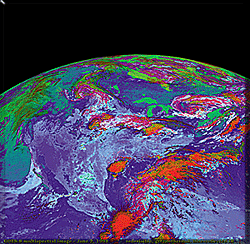Conclusion
 In
recent times civilization has clearly become both an agent and a potential
victim of change. The impacts of human-induced changes on the climate
system, on air and water quality, on land use, and on the diversity of
life will almost certainly increase in the 21st Century. With an increasing
world population, an expanding global economy, and the development of
new technologies, humans have become powerful agents for environmental
change on global, regional, and local scales. Over the period since the
industrial revolution, scientific evidence has documented environmental
changes that are the result of a complex interplay among a number of natural
and human-related systems.
In
recent times civilization has clearly become both an agent and a potential
victim of change. The impacts of human-induced changes on the climate
system, on air and water quality, on land use, and on the diversity of
life will almost certainly increase in the 21st Century. With an increasing
world population, an expanding global economy, and the development of
new technologies, humans have become powerful agents for environmental
change on global, regional, and local scales. Over the period since the
industrial revolution, scientific evidence has documented environmental
changes that are the result of a complex interplay among a number of natural
and human-related systems.
Our past successes have helped us understand the causes and impacts of the Earth's natural variations in the atmosphere, oceans, and the planet's interior and surface. This knowledge, in turn, has led to a better understanding of how those variations can affect our lives and has begun to illuminate how our current actions can cause future change.
This plan for the Directorate for Geosciences is an integral part of the overall National Science Foundation strategic plan for achieving national and international goals. It is built on the knowledge base that has emerged from our past accomplishments in research and responds to the challenges posed by the interactions between the environment and human activities. The plan outlines the scientific directions needed to continue the expansion of our base of knowledge of Earth systems through thoughtful investments in ideas, people, and tools necessary to accomplish our goals.
 Our
increased understanding, combined with the powerful observing and monitoring
capabilities described in this plan, can create skillful predictions of
future variations in our planetary system. With this capability comes
a responsibility to provide relevant information to society in a timely
and comprehensible manner and to help educate our citizens and leaders
so that they can make informed decisions responding to environmental changes.
Our
increased understanding, combined with the powerful observing and monitoring
capabilities described in this plan, can create skillful predictions of
future variations in our planetary system. With this capability comes
a responsibility to provide relevant information to society in a timely
and comprehensible manner and to help educate our citizens and leaders
so that they can make informed decisions responding to environmental changes.
This plan is a key element in setting a very important course for the nation. We may long for the simpler times in which nature functioned beautifully and mysteriously, and we did not pose a threat to it. However, we do have knowledge that we do pose potentially serious threats to the environment and consequently we are challenged to act responsibly to sustain our planet's habitability. With that challenge comes the exciting vision — that we can shape and determine a course that will allow both our society and our unique planet to have a healthy and prosperous future.


